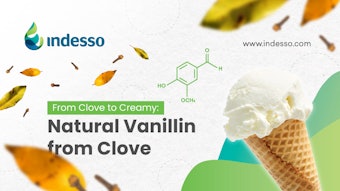With first pre-registration fast approaching, manufacturers and suppliers of chemical substances are bracing themselves for the impact of REACH—the new chemical regulation introduced by the European Union.
Described in some quarters as possibly the most complex set of regulations issued by an international organization, REACH may appear to be a minefield for those it affects. With so many factors to consider, the challenge for companies is gaining a thorough understanding of the implications that REACH will have on their business activities.
Here, Treatt provides a step-by-step guide to the scope of REACH regulation. The company offers insights from an EU-based company’s perspective, presents key considerations and helpful hints to get prepared for REACH. It demonstrates that with careful planning and preparation, REACH is not the daunting task it may initially seem.
REACH Explained
REACH—the Registration, Evaluation, and Authorization (and Restriction) of Chemicals—is the new European Union regulation that came into force on June 1, 2007. It replaces a number of European directives and regulations with a single system. It will apply to European chemical companies who manufacture and/or import chemical substances into the EU in quantities of more than one tonne per legal entity.
The new regulation aims to generate data on the effects of chemical substances so that they may be used safely. Manufacturers and importers who place chemicals on the market will now be responsible for understanding and managing the risks associated with their use. This should result in a more innovative and competitive European chemical industry that also encourages the substitution of toxic chemicals with safer alternatives.
The key element of the REACH regulation is the requirement for manufacturers or importers of chemicals to register them with the European Chemicals Agency (ECHA). A registration dossier will be supported by a standard data set on that substance. However, the data requirement for each substance will be dependent on the amount that is manufactured or supplied and the toxicity of the substance. So, the largest volume and most toxic substances will require the most data for their registration dossiers. If chemicals are not pre-registered and then registered, the substance will not be able to be sold.
Breadth of REACH
It cannot be denied that REACH regulation is extremely complex. A huge number of substances used in the flavor and fragrance industry will be affected by the new regulation. These include fragrance ingredients (e.g., aroma chemicals, essential oils and natural extracts), flavors in oral care products (e.g., mint oils), flavors in tobacco and isolated intermediates. There are some exclusions such as substances deemed generally safe (e.g., water, corn oil), preparations (mixtures of substances/blends), flavor and food ingredients and additives, pharmaceutical ingredients and non-isolated intermediates. Essential oils and natural extracts are only included if they are used as flavor or fragrance ingredients in cosmetics.
D-days
With estimates showing around 30,000 substances supplied in quantities of one tonne or more per year on the European market, registering these items presents a significant challenge. To facilitate the process, the first phase is a pre-registration phase which provides companies with a six-month window (from June 1 until December 1, 2008) to submit a limited amount of data to the ECHA. By submitting data within this period, companies will be able to benefit from the staggered registration periods set in REACH for phase-in substances.
The pre-registration phase is also in place to allow companies that manufacture or import the same substances to form groups or SIEF (substance information exchange forums) where data is shared to avoid duplication during the registration process. Here, participants must agree on the classification and labeling of their substances. They must provide other participants with existing research, respond to information requests and collectively identify the need for future studies and arrange for them to be carried out.
This is followed by registration, where manufacturers and importers submit information dossiers on substances to the ECHA. Registration is based on two parameters: quantity and toxicity. The timeframe for the process from pre-registration to the final phases of registration is a decade.
These initial deadlines have been set to ensure the most frequently-used and most toxic substances are assessed in the first phase. The substances and dossiers are then evaluated by the ECHA to confirm reliability of all submitted data and authorized for specified use. To place substances with properties that are deemed to be of “very high concern” on the market, an authorization process must be applied for by June 1, 2009. A company wishing to market or use such a substance must submit an application to the ECHA. Authorization is then decided by the European authorities.
Getting Ready for REACH
Once the full scope of REACH has been understood, it is essential to assess the implications for product portfolios. A key consideration will be the potential need for reformulation; some substances may become unavailable if suppliers are unable to comply with the regulation.
Treatt’s range of products, for example, can be divided into three groups: essential oils and extracts, aroma chemicals and blends (or preparations as they are described in REACH). Each will be treated differently under REACH regulation.
Essential oils and extracts: By far the most complicated category, essential oils and extracts are referred to as Natural Complex Substances (NCS) within the industry or Substances of Unknown or Variable composition (UVCBs) under REACH. Many of these substances are imported into the EU in quantities greater than one tonne per year. The challenge for this category is that many of these substances have been used for hundreds of years, and as a result are generally recognized as safe. This means that the necessary test data has never been generated. Therefore, many companies possess the physico-chemical data but lack testing facilities to produce the required human and environmental exposure data. The European Flavor & Fragrance Association and the European Federation of Essential Oils have formulated a plan to assist the industry in preparing for the registration of Natural Complex Substances. This is primarily through the formation of pre-consortia which preempt the substance information exchange forum described in the regulation. For the highest priority aroma chemicals and naturals, namely those requiring registration in 2010, this process has already started.
Aroma chemicals: Aroma chemicals can be considered ‘well defined substances’—substances with a defined qualitative and quantitative composition that can be sufficiently identified based on the required identification parameters. Initial assessments have indicated that for importers and distributors of these substances, like Treatt, much of the required data is already available or will become available through data sharing. However, assessment of volumes and supply lines will be necessary to determine which substances importers will need to register.
Preparations or blends: Although preparations or blends do not need to be registered under REACH, companies must record the substances in these preparations that are present in quantities greater than one tonne per year.
Implications for the Supply Chain
The impact of REACH will be felt throughout the supply chain. From raw material suppliers to end product manufacturers, everyone will be affected by the new regulation. Suppliers in the EU, for example, will now be assessed differently to those outside the EU who have no registration obligations. Suppliers outside the EU cannot register for REACH directly. They can, however, opt to nominate an ‘only representative’—an EU-based representative of a non-EU manufacturer. Appointing an ‘only representative’ allows manufacturers to participate in the REACH process and ensures that they will be able to market their product directly in the EU. It also has advantages for EU importers. They are spared the task of registering the product under REACH and will be regarded as a downstream user.
Throughout the REACH process, customer needs should remain paramount. To maintain optimum customer service, Treatt, for example, has appointed a dedicated coordinator for REACH-related matters to respond to all customer and supplier queries. This contact is an in-house expert on the regulations, providing support to the technical, sales and purchasing teams on REACH-related matters, and assisting senior management in developing a company action plan.
The Three Cs
Those affected by REACH should consider the three Cs when implementing an action plan: communication, confidentiality and costs.
Communication is key. REACH preparation will rely on effective communication between sales, purchasing and regulatory departments. It will involve extensive training, data collection and migration. The finance department will also need to ensure sufficient funds are in place for testing, compensation of existing data holders and the registration process.
Secondly, confidentiality will be an issue with so much dialogue between different members of the supply chain. According to REACH, any details that undermine commercial interests will not be passed on but information relating to safety will never be confidential.
Finally, the costs of compliance will be significant. The authorities are making concessions mindful of the number of SMEs that will be affected. However, there will be financial implications at every stage of REACH that must be considered carefully. Some of these costs may have to be passed along the supply chain, making it essential to keep abreast of any product margin developments that are business critical.
Summary
There is no doubt that REACH will have a huge impact on the European chemical industry. In fact, it has already had a huge affect on the flavor and fragrance industry; many competitors are finding ways to work together to reach a common goal. However, despite its challenges, the regulation will offer significant benefits, improving safety and preserving the environment. With careful and advanced preparation, companies can ensure they comply with REACH and continue to run their business effectively and efficiently.










